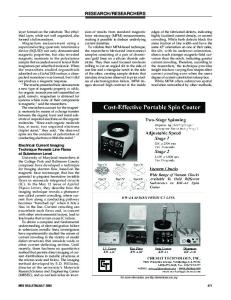Temperature-stable dielectric ceramics in Ba 4 Nd 2 Ti 4 Ta 6 O 30 /(La 0.1 Bi 0.9 ) 2 Ti 2 O 7 biphase system
- PDF / 199,553 Bytes
- 4 Pages / 612 x 792 pts (letter) Page_size
- 46 Downloads / 287 Views
MATERIALS RESEARCH
Welcome
Comments
Help
Temperature-stable dielectric ceramics in Ba4Nd2Ti4Ta6O30 /(La0.1Bi0.9)2Ti2O7 biphase system J. Wang, X.M. Chen, and J.S. Yang Laboratory of Materials for Electronics and Communication, Department of Materials Science and Engineering, Zhejiang University, Hangzhou 310027, China (Received 17 February 1999; accepted 14 May 1999)
Biphase dielectric ceramics in the system of (1 − x)Ba4Nd2Ti4Ta6O30/ x(La0.1Bi0.9)2Ti2O7 were investigated to obtain a near-zero temperature coefficient of dielectric constant. With the increase in x, the dielectric constant increased slightly, and the temperature coefficient changed from negative to positive. High dielectric constant of ⳱ 143 and good temperature stabibility ( ⳱ −48 ppm/ °C) were achieved in a composition of x ⳱ 0.45, and the increased dielectric loss became the new problem.
I. INTRODUCTION
Dielectric ceramics are widely used with advances in microwave communication1–6 and microelectronic technologies,7,8 and high dielectric-constant ceramics have received intensive attention in reducing the size of microelectric circuits, where low dielectric loss and nearzero temperature coefficient of the dielectric constant are required for many applications. Recently, Chen et al.9,10 reported Ba4Nd2Ti4Ta6O30 as a promising candidate for high-performance dielectric ceramics. It has a tungsten-bronze structure, a dielectric constant of above 130, and a dielectric loss of 0.0007 ( f ⳱1 MHz) but a large negative temperature coefficient () of −1500 ppm/°C. Meanwhile, it was reported that the layer structure compound (La0.1Bi0.9)2Ti2O711 has a high (⳱ 130) and a large positive temperature coefficient of +1035 ppm/°C. So whether temperature-stable dielectric ceramics can be created by combining these two phases is an interesting question. In the present work, aimed at developing highdielectric-constant ceramics with small , the combination of Ba4Nd2Ti4Ta6O30 and (La0.1Bi0.9)2Ti2O7 is investigated. The possibility of two-phase coexistence in Ba4Nd2Ti4Ta6O30–(La0.1Bi0.9)2Ti2O7 system is discussed, together with the effects upon sintering temperature and dielectric properties of the present ceramics. II. EXPERIMENTAL
The Ba4Nd2Ti4Ta6O30 component used in this study was prepared by conventional ceramics processing. Reagent grade BaCO3, Nd2O3, TiO2, and Ta2O5 were used as raw materials. They were mixed and ball-milled in ethanol for 24 h, then dried and calcined at 1300 °C in air for 3 h. The calcined powders were remilled for one day J. Mater. Res., Vol. 14, No. 8, Aug 1999
http://journals.cambridge.org
Downloaded: 14 Mar 2015
and dried. The layer structure (La0.1Bi0.9)2Ti2O7 was synthesized by a similar method. Starting materials were reagent grade oxide powders of La2O3, Bi2O3, and TiO2. The mixed powders were calcined at 850° and 1000° in air for 3 h. The Ba4Nd2Ti4Ta6O30 and (La0.1Bi0.9)2Ti2O7 powders were batched for the composition (1 − x) Ba4Nd2Ti4Ta6O30/x(La0.1Bi0.9)2Ti2O7 with 0 ⱕ x ⱕ 1 and mixed with an organic binder, 5 wt%PVA
Data Loading...











